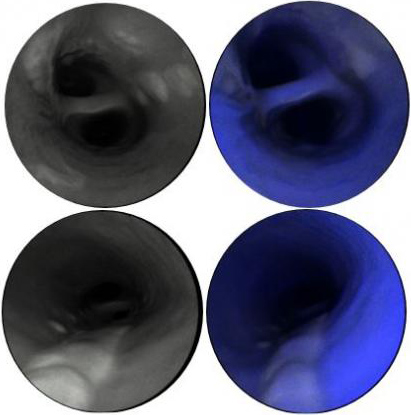Intravascular camera helps assess dangerous plagues
A collaboration between scientists at University of Washington and University of Michigan has led to the development of a new way of imaging atherosclerosis within blood vessels. The technology relies on delivering a tiny camera into a vessel’s lumen and illuminating the plagues using red, green, and blue lasers.
The scanning fibre endoscope (SFE) was originally developed at UW to visualise cancer cells, but its small size and multi-modal imaging warranted testing its capabilities inside of vessels.

Scanning fibre angioscopic images with red reflectance for structural images (left) and blue fluorescence for label-free biochemical contrast (right). Images demonstrate multiple atherosclerotic lesions with very low fluorescence in the blue spectrum in comparison to the surrounding healthy artery.
The device is able to provide a structural analysis of lesions that can result in strokes and heart attacks, as well as assess whether a vessel needs stenting. Moreover, it may be possible to use the technology to guide targeted drug delivery and assist physicians performing vascular procedures.
“The ability to identify and monitor the biological markers that render a plaque unstable and at risk for rupture could enable the detection of individuals within high-risk populations who are most likely to suffer from cardiovascular events, and therefore benefit the most from preventive treatment during the asymptomatic stage,” in a statement said B. Gregory Thompson, M.D., professor of neurosurgery at the University of Michigan Medical School and a senior author of the study.
“In addition, plaque-specific data could help physicians modulate treatment intensity of atherosclerosis, which is currently based on systemic surrogates such us cholesterol and blood sugar levels and occurrence of cardiovascular events such as stroke or myocardial infarction.”
The imaging system is able to render high resolution 3D images of plagues in real-time at 30 Hz, all without relying on contrast agents or biochemical labels. Proof of concept trials on animals have shown the ability to provide high quality images of mid-sized vessels, and to help grade plagues as to their danger levels.





